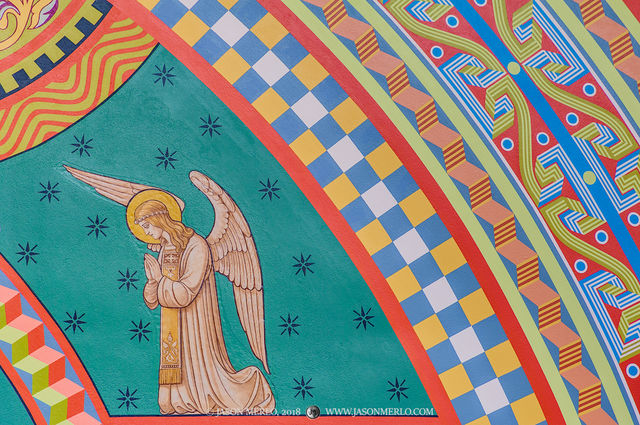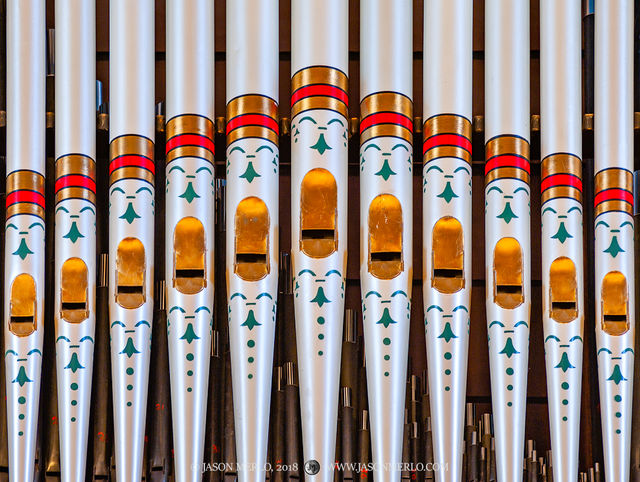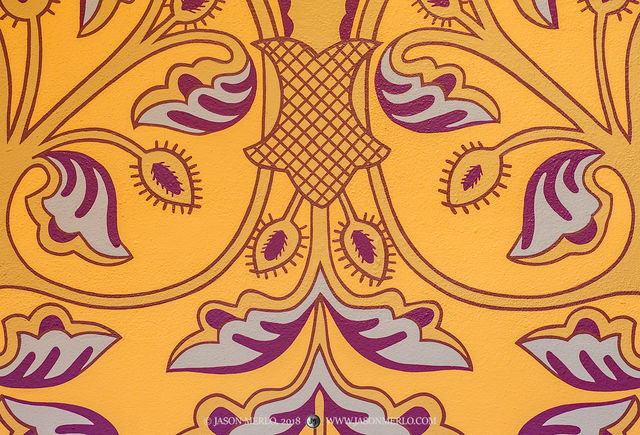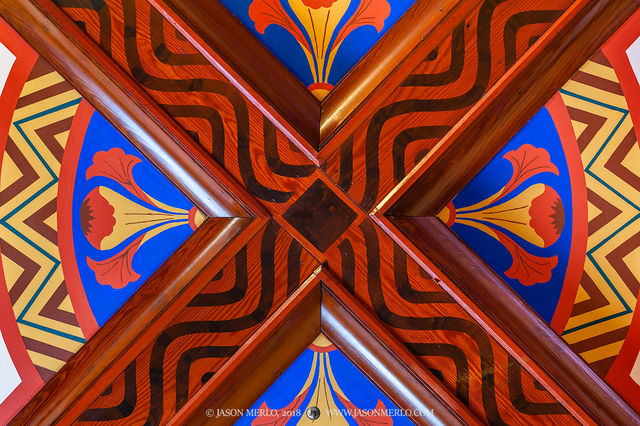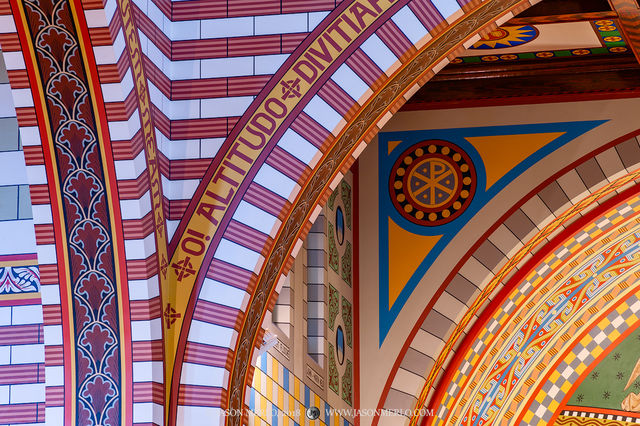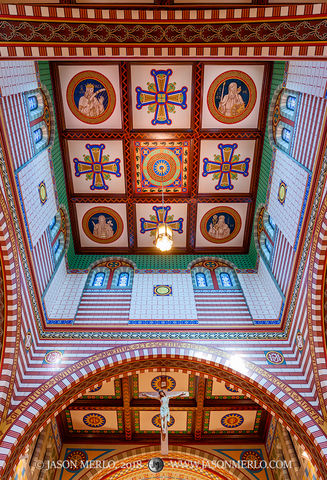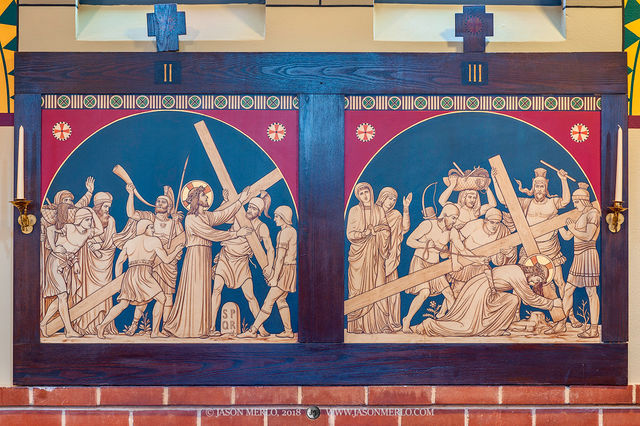About St. Peter's Catholic Church (Lindsay)
This gallery contains images of St. Peter's Catholic Church in Lindsay, one of the Painted Churches of Texas.
St. Peter’s Church, located in the village of Lindsay, Texas, is an imposing religious edifice of Romanesque architectural inspiration. Designed by Dutch immigrant architect Frank A. Ludwig, and built in 1918, the brick-veneer church exhibits a complex massing of forms characteristic of German Romanesque churches of the 11th and 12th centuries. Semicircular arches are used throughout the church for windows, doors, and decorative moldings.
The plan of the church is a Latin cross, with a tower over the crossing of the nave and transept, and a single tall, rectangular bell tower over the entrance on the main east façade. Round-arched clerestory windows light the nave. Courses of finished stone masonry divide the brick bell tower into spire, belfry, shaft, and entry. The main entrance to the church is through a large door distinguished by brick archivolts at the base of the tower. Further embellishing the tower are a sculpture niche flanked by two Greek crosses, and arched window, and a rose window. The belfry atop the tower is pierced by louvered pairs of Romanesque arches opening on each side. Capping the tower is a massive helm-shaped roof covered by slates. The crossing of the nave and transept is marked by a square lantern tower which is pierced by pairs of arched windows. The tower has a pyramidal roof covered, like the rest of the church, in red clay tile. Gold Celtic crosses top both the lantern tower and the spire.
Raised on a base of coursed rough ashlar, the church walls are constructed of reinforced concrete with exterior brick veneer. The severe exterior side walls are articulated by filled brick arches pierced by pairs of arched windows. Further embellishment is provided by small eave brackets and an arcaded corbel table of stone extending around the church just below the eave of the nave, transept, and lantern tower. This detail is repeated above the aisle doorways on the entry façade.
In plan, the interior provides an especially well-developed example of Romanesque inspiration, with nave, aisles, transepts, and semicircular apse. All of the wall and ceiling surfaces have been painted in a manner reminiscent of Italian Gothic and Byzantine interiors. St. Peter’s interior was almost entirely the work of Swiss immigrant artist Friedolin Fuchs. The nave is covered by a coffered ceiling with varnished wooden beams painted in blue and black geometric shields and medallions, executed in colors of yellow gold, rusty brown, black, green, blue, and red, on a background color of ivory. Ceiling panels over the side aisles and transept arms are similar in character and color. More elaborate motifs are found in the ceiling over the crossing, with pictorial representations of saints.
Dividing the nave from side aisles are simple, heavy columns which support a brick arcade. Designs painted to resemble various masonry effects adorn the stuccoed walls. Courses of off-white, solid blocks alternate with courses of striped blocks in light and rusty brown, giving a contrasting effect similar to that used in English High Victorian, Italian Romanesque, Gothic, and Byzantine churches. The arches are painted to resemble voussoirs in the same pattern. On the upper walls, at clerestory level, a motif of light beige blocks with brown mortar is found, each with a center, stylized flower. A fourth masonry effect is found around the windows, where blocks and voussoirs occur in alternating tones of light and dark grey with black mortar. Additional interest is added to the wall by friezes of geometrically stylized plant motifs in black, yellow gold, and light brown. At the uppermost portion of the wall at the crossing, additional geometric bands separate the lower diaper pattern from the upper masonry pattern. Some of these patterns have precedent in medieval manuscript borders.
An effect similar to Byzantine mosaics is achieved in the half-dome over the apse, through the use of checked concentric and interlocking bands. Saints Mathew, Mark, Luke and John surround Christ in majesty, while angels, lambs, and other creatures further adorn the space. Beneath the pictorial representations are panels with central crosses surrounded by filigree patterns. Between these panels and the lower area of striped masonry, near the confessionals, is a very stylized representation of curtains. Paintings of St. Benedict and St. Boniface (patron saint of Germany) line the transept walls. These were painted by Dr. Mathias Zell, father of Father Bernard Zell, the church pastor from 1910 to 1923.
Significance
St. Peter’s Church, which was listed in the National Register on May 25, 1979, is an unusual and impressive ecclesiastical monument. Designed by a newly arrived Dutch immigrant for a town of recent German immigrants, the church is far from the mainstream of American architecture of that day, and reflects none of the dominant trends of the early 20th century eclecticism. Instead, the building is of direct European ancestry, having been inspired by 11th and 12th century German Romanesque models. The manner in which the large mass of the church dominates the surrounding town and countryside is similarly reminiscent of a European background. St. Peter’s Church provides an important architectural statement of the ancestry of the German Catholics who founded and settled the town of Lindsay. While the exterior is outstanding for its architecture, the interior decorative painting contributes to the building’s significance. Among religious buildings in Texas, St. Peter’s is one of the most sophisticated and elaborately painted churches now known.
The farming community of Lindsay was founded in 1891, through the effort of Anton and William Flusche, Catholic German immigrants who had previously established successful farm communities in Iowa, Kansas, and Texas. St. Peter’s Parish was established a year later, in March of 1892, when the first Mass was celebrated at the home of William Flusche. The first church was a wooden frame building, built that same year. In 1903 it was replaced by an imposing brick structure with central bell tower, designed by O. Klutho of St. Louis, which was devastated by a tornado in May 1917. Only the tower and a portion of the apse survived. Plans were immediately made for building a replacement structure. Much manual labor for the erection of the new church was provided by members of the parish, who salvaged bricks from the ruins of the earlier building, and saved old windmill towers to be used as concrete reinforcement.
The architect of the new church, Frank A. Ludewig, was born in Holland about 1870, and was practicing there before immigrating to St. Louis shortly before World War I. Through contacts in the Catholic community, Ludewig obtained many commissions for midwestern Catholic churches. He remained active into the 1930s, and died at the Josephinum in Columbus (Worthington), Ohio, which he had designed in 1925.
The lavish decoration of the interior walls of the Lindsay church was largely done by another immigrant artist, Friederich Fuchs, who had settled in St. Louis after emigrating from Switzerland. With its rich variety of colors and textures, Fuchs’ wall painting is a fine example of trompe l’oeil folk art, revealing the possible inspiration of Romanesque and Italian Gothic churches. The church has been maintained in excellent condition, and has continually served the parish for over sixty years.
Source
Kennedy, C., Butler, L. F., & McCann, M. (1983). Churches in Texas with Decorative Interior Painting (National Register of Historic Places Thematic Nomination) (pp. 16-19) (United States, Texas Historical Commission).
Prints and Licensing
For more information regarding licensing images or purchasing photos as prints click here. If you have a specific inquiry please feel free to contact me using the website's contact form here.



